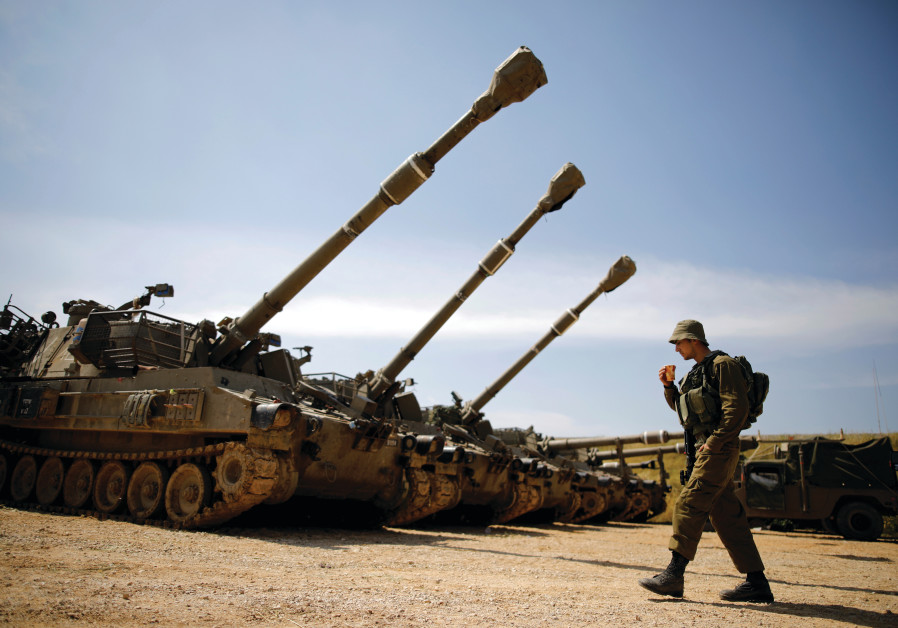The Great March to war?

A soldier stands near a battery of cannons near the Gaza border, March 28th, 2019. (photo credit: AMIR COHEN/REUTERS)
Prime Minister Benjamin Netanyahu’s trip to the Gaza border to see tanks and soldiers Thursday almost seemed reassuring in a week that began with a direct rocket hit on a home in the center of the country.
That sight of the demolished house and the miraculous survival of the seven family members inside served as a reminder to the Israeli public that they were not immune from the long and deadly arm of the slow brewing conflict in Gaza.
With visions of possible death randomly raining from the skies, Netanyahu’s statement of a possible extensive military campaign in the Gaza Strip almost made it seem as if finally the government and the IDF planned to take steps to end the threat from Hamas-ruled enclave.
Right-wing Israeli politicians have claimed that only lack of political or diplomatic will has kept the IDF from rooting out Hamas in Gaza and destroying its cache of weapons and rockets.
New Right Party head and Education Minister Naftali Bennett called for the IDF “to open the gates of hell” against Hamas.
United Nations Ambassador Danny Danon warned this week during a Security Council debate, “If the terror from Gaza continues, the Hamas leadership will feel the strength of the IDF and be buried in the tunnels of Gaza.”
But if Israel could easily bury Hamas, it would have done so already. In the last decade, the IDF has fought three wars against Hamas; in 2009, in 2012 and in 2014. In each conflict, it could have claimed victory, with Gaza bearing the brunt of the casualty counts and the destroyed homes.
But when the dust of war settled it was clear that far from vanquishing Hamas, however, its military might had only grown, from a terror organization that could barely hit Sderot 18 years ago to one that can fire deadly missiles beyond Tel Aviv.
Short of carpet bombing Gaza, or reoccupying it, another military campaign is more likely to continue the pattern of ratcheting up more demolitions and death but is unlikely to unseat or disarm Hamas.
Netanyahu, therefore, has been hesitant to seek a military solution. As a result, in the last year, Hamas and Israel have been entwined in a cautious dance that come ever closer to the precipice. The country has repeatedly seemed to be on the edge of war with Gaza rockets flying like sudden sun showers that dissipate almost as quickly as they fell.
The slow, on-again, off-again drum beat of war has been helped by the Great March of Return, which began on March 30 as a six-week event and has yet to end.
Hamas was able to siphon off the frustration of the deteriorating humanitarian situation in Gaza — made worse by Palestinian Authority sanctions — into weekly protests against Israel.
The low-level violence, including infiltration attempts, explosive devices, burning tires, stone throwing and Molotov cocktails, was enough to warrant a response but not enough to trigger a war.
The incendiary devices launched from Gaza against Israel which burned thousands of hectares of fields and forests prompted IDF retaliatory strikes but did not warrant a full-scale conflict.
IDF response to the protesters, which has included live fire and tear gas, has lead to more than 270 deaths and close to 30,000 injuries, according to the Hamas-run Health Ministry.
In the diplomatic arena, the Palestinian Authority was able to score points by painting the protests as peaceful, and highlighting the disproportionate nature of the violence.
The success culminated this month with the United Nations Human Rights Council creating a list of Israelis it holds to be culpable of war crimes along the Gaza border, with an eye to handing the list to the International Criminal Court in The Hague.
In the field, however, the march has not changed the deteriorating situation in Gaza for the Palestinians.
Rather, as time has gone on, the ongoing protest and riots have begun to play the role of a match in a dry field. At a time of high tension, such as now, when Hamas and Israel appear on the brink of a new conflict, violence along the border, including this weekend, could provide the spark that pushes the IDF and Hamas into a full-blown war.
Join Jerusalem Post Premium Plus now for just $5 and upgrade your experience with an ads-free website and exclusive content. Click here>>





Comments are closed.